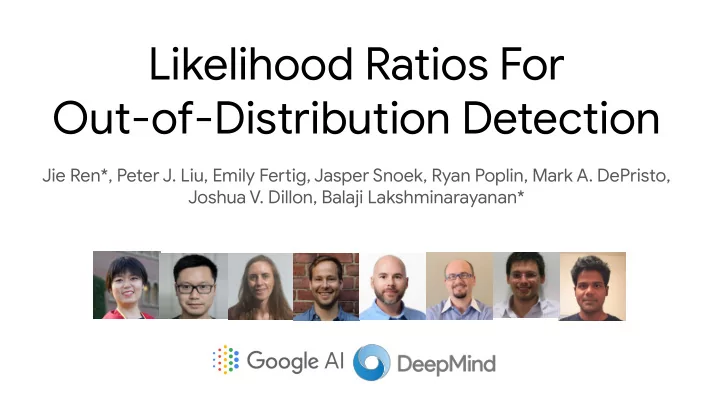

Likelihood Ratios For Out-of-Distribution Detection Jie Ren*, Peter J. Liu, Emily Feruig, Jasper Snoek, Ryan Poplin, Mark A. DePristo, Joshua V. Dillon, Balaji Lakshminarayanan*
Motivation: Why is OOD detection imporuant? ● Bacteria identifjcation based on genomic sequences ○ ACGTTAACAACC...GGCTTC ⇒ label ○ Holds the promise of early detection of disease ● Classifjer can achieve high accuracy on cross-validation ● But, the classifjer can pergorm poorly in real world: ○ 60-80% data belonging to as yet unknown bacteria ○ Assign high-confjdence predictions to OOD inputs, than say “I don’t know” Need accurate OOD detection to ensure safe deployment of classifjer ●
Generative models for OOD detection? Pros: do not require labeled data; model the input distribution p( x ) and then ● evaluate the likelihood of new inputs Cons: can assign higher likelihood to OOD inputs! ● Nalisnick et al., 2018, Choi et al. 2019. ○ Fashion-MNIST (in-dist.) vs. MNIST (OOD) Genomics
What does p( x ) represent? Examples of B ackground vs. S emantics: ● B ackground ○ Images : background + objects ○ Text : stop words + key words ○ Genomics : GC background + motifs S emantics ○ Speech : background noise + speaker Likelihood p( x ) has to explain both semantic and background components ● can be dominant the focus Humans ignore background and focus primarily on semantics for OOD ● Question : how do we automatically extract semantic component of p(x)? ●
Likelihood Ratio for OOD Detection To focus on x S we propose: 1. Training a background model on peruurbed inputs 2. Computing the likelihood ratio ● LLR is a background contrastive score : the significance of the semantics compared with the background.
Which pixels contribute the most to likelihood (ratio)? PixelCNN++ model trained on FashionMNIST ● Heatmap showing per-pixel contributions on Fashion-MNIST (in-dist) and MNIST (OOD) ● Likelihood ratio focuses more on the semantic pixels and Likelihood is dominated by background pixels, which explains why MNIST (OOD) is assigned higher p(x) signifjcantly outpergorms likelihood on OOD detection
OOD detection for genomic sequences Method AUROC Likelihood 0.626 Likelihood Ratio 0.755 Classifjer-based p(y|x) 0.634 Classifjer-based Entropy 0.634 Classifjer-based ODIN 0.697 Likelihood is heavily Likelihood Ratio Classifjer Ensemble 5 0.682 afgected by GC bias corrects for GC bias Classifjer-based 0.525 Mahalanobis Distance
Summary Likelihood from deep generative models can be afgected by background ● The proposed Likelihood Ratio method efgectively corrects for background, ● and outpergorms the raw likelihood on OOD detection Release a realistic benchmark dataset for OOD detection in genomics ● Our method achieves SOTA pergormance on genomic dataset ● New benchmark dataset + code is available at htups://github.com/google-research/google-research/tree/master/genomics_ood
Recommend
More recommend